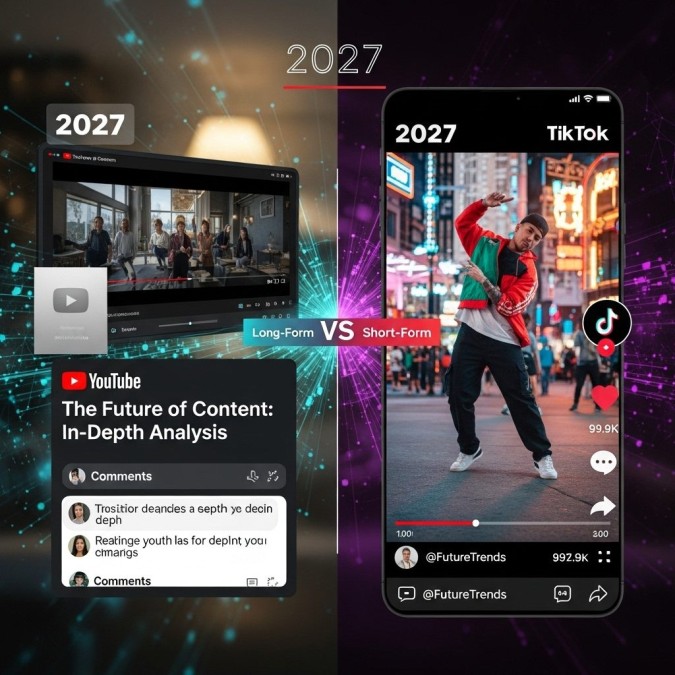📱 YouTube vs. TikTok: Long-Form vs. Short-Form in 2027
The Format War That’s Shaping the Future of Content Creation
Section 1: The Rise of Format-Driven Platforms — How We Got Here
In the early 2020s, YouTube and TikTok were already locked in a battle for attention. YouTube, the veteran platform, had built its empire on long-form content—educational videos, vlogs, documentaries, and deep-dive explainers. TikTok, the disruptor, introduced a radically different model: short, addictive, algorithmically curated clips that rewarded spontaneity and virality over polish and depth.
Fast forward to 2027, and the divide between long-form and short-form content has become more than just a stylistic choice—it’s a strategic decision that affects monetization, audience psychology, and brand identity.
📈 Platform Evolution
- YouTube’s Expansion: YouTube has doubled down on long-form content, introducing AI-assisted editing tools, enhanced monetization tiers, and deeper analytics for creators. It remains the go-to platform for tutorials, reviews, podcasts, and serialized storytelling.
- TikTok’s Growth: TikTok has expanded its video length to 30 minutes, but its core remains short-form. Its algorithm is now powered by real-time behavioral AI, capable of predicting not just what users want—but what they’ll want next.
- Cross-Pollination: Both platforms have borrowed from each other. YouTube launched Shorts to compete with TikTok’s format, while TikTok introduced longer videos and playlists to retain viewers.
🧠 Audience Behavior in 2027
The modern viewer is fragmented. Gen Z and Gen Alpha consume content in micro-moments—between classes, during commutes, or while multitasking. They favor TikTok’s brevity and authenticity. Millennials and older generations still prefer YouTube’s depth and searchability, especially for educational or purchase-driven content.
This divergence has led to a new kind of creator: one who understands not just what to say, but how long to say it, and where.
Section 2: Creator Strategy in 2027 — Monetization, Reach, and Format Mastery
For creators, the format war is no longer about choosing sides—it’s about mastering both. In 2027, successful creators operate like media companies, tailoring content to platform-specific algorithms, audience expectations, and monetization models.
💰 Monetization Models
| Platform | Monetization Strengths | Weaknesses |
|---|---|---|
| YouTube | Ads, memberships, Super Thanks, sponsorships, affiliate links | Slower growth, high production cost |
| TikTok | Creator Fund, brand deals, live gifts, TikTok Shop | Lower CPM, unpredictable virality |
Creators now use TikTok for top-of-funnel visibility and YouTube for bottom-of-funnel conversion. A viral TikTok can drive traffic to a YouTube channel, where longer videos build trust, explain products, and convert viewers into paying customers.
🧩 Format Strategy
- Short-Form (TikTok, Shorts, Reels)
- Ideal for trends, teasers, behind-the-scenes, and quick tips
- Drives discovery and engagement
- Requires high frequency and adaptability
- Long-Form (YouTube, Podcasts)
- Ideal for tutorials, reviews, storytelling, and deep dives
- Builds authority and loyalty
- Requires planning, scripting, and editing
Smart creators segment their content: a 30-second TikTok teaser leads to a 15-minute YouTube tutorial. A viral dance trend becomes a case study on YouTube. The platforms are no longer competitors—they’re complementary tools in a creator’s arsenal.
📊 Analytics and AI
In 2027, creators rely on AI-powered dashboards that track not just views and likes, but emotional resonance, retention curves, and conversion probabilities. TikTok’s real-time feedback loop helps creators iterate fast, while YouTube’s deep analytics support long-term strategy.
Creators who understand these tools can optimize thumbnails, titles, and even facial expressions to maximize engagement. It’s not just content—it’s content science.
Section 3: The Future of Engagement — Algorithms, Psychology, and the Hybrid Creator
As we look ahead, the battle between long-form and short-form isn’t about which format will win—it’s about how creators will blend them to serve increasingly complex audience needs.
🧠 Algorithmic Personalization
TikTok’s algorithm in 2027 is a marvel of behavioral prediction. It doesn’t just serve content—it anticipates moods. If a user is stressed, it might show calming videos. If they’re curious, it might surface educational clips. YouTube’s algorithm, while slower, is more deliberate—favoring watch time, search intent, and topic relevance.
Creators must now design content with algorithmic empathy: understanding not just what their audience wants, but what the algorithm thinks they want.
🧠 Audience Psychology
- Gen Z / Alpha: Crave authenticity, humor, and rapid feedback. Prefer TikTok’s rawness and relatability.
- Millennials / Gen X: Value depth, structure, and credibility. Prefer YouTube’s searchability and polish.
- Hybrid Consumption: Many users now consume both formats—watching TikTok during breaks and YouTube during focused sessions.
This shift has led to the rise of the hybrid creator: someone who can be funny in 15 seconds and insightful in 15 minutes. They use TikTok to build personality and YouTube to build authority.
🔮 What’s Next?
- AI-Generated Content: Creators now use AI to generate scripts, edit videos, and even simulate their own voice and likeness.
- Interactive Formats: Viewers can now choose story paths, vote on outcomes, and co-create content.
- Platform Convergence: TikTok and YouTube may eventually merge features—offering both short-form virality and long-form depth in a single feed.
The future isn’t about choosing long or short—it’s about choosing smart. Creators who understand format psychology, platform mechanics, and audience behavior will thrive. Those who cling to one format may be left behind.
📝 Final Thoughts
In 2027, the format war between YouTube and TikTok has matured into a strategic dance. Long-form and short-form are no longer rivals—they’re tools. The creators who win are those who understand how to wield both, tailoring their message to the moment, the mood, and the medium.
Whether you’re a brand, educator, entertainer, or entrepreneur, the question isn’t “YouTube or TikTok?” It’s “How do I use both to tell my story?”



